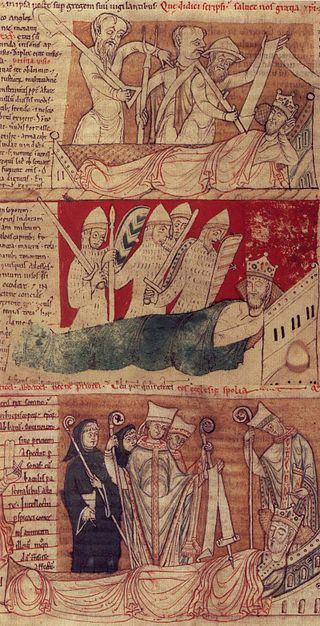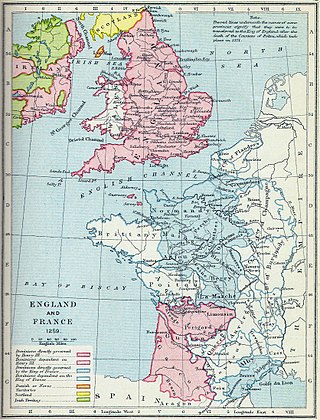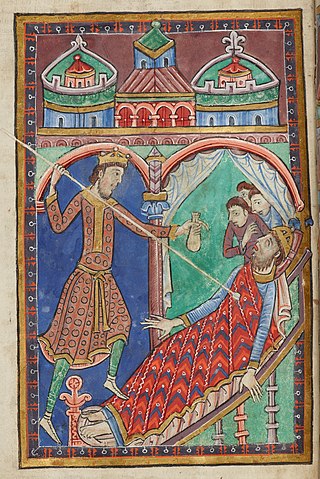
Matthew Paris, also known as Matthew of Paris, was an English Benedictine monk, chronicler, artist in illuminated manuscripts, and cartographer who was based at St Albans Abbey in Hertfordshire. He authored a number of historical works, many of which he scribed and illuminated himself, typically in drawings partly coloured with watercolour washes, sometimes called "tinted drawings". Some were written in Latin, others in Anglo-Norman or French verse. He is sometimes confused with the nonexistent Matthew of Westminster.
Florence of Worcester was a monk of Worcester, who played some part in the production of the Chronicon ex chronicis, a Latin world chronicle which begins with the creation and ends in 1140.

Edmund the Martyr was king of East Anglia from about 855 until his death.

The Flores Historiarum is the name of two different Latin chronicles by medieval English historians that were created in the 13th century, associated originally with the Abbey of St Albans.
Sir John Maunsell, Provost of Beverley Minster, was a king's clerk and a judge. He served as chancellor to King Henry III and was England's first secretary of state.

The Abbey of Bury St Edmunds was once among the richest Benedictine monasteries in England, until its dissolution in 1539. It is in the town that grew up around it, Bury St Edmunds in the county of Suffolk, England. It was a centre of pilgrimage as the burial place of the Anglo-Saxon martyr-king Saint Edmund, killed by the Great Heathen Army of Danes in 869. The ruins of the abbey church and most other buildings are merely rubble cores, but two very large medieval gatehouses survive, as well as two secondary medieval churches built within the abbey complex.
John de Taxster, Taxter, or Tayster, sometimes erroneously called Taxston, was a 13th-century English chronicler and monk at Bury St Edmunds Abbey. Nothing is known of his life apart from what is reported in or understood from his work on the 13th and 14th-century Bury Chronicle.

Geoffrey de Runcey (1340s?–1384) was a 14th century chronicler and abbey servant who wrote a valuable, although now-incomplete journal of his travels around medieval East Anglia.
John of Trokelowe was an English chronicler and Benedictine monk of the fourteenth century. He was a monk of St Albans Abbey, and in 1294 was living in the dependent priory of Tynemouth, Northumberland. Once he was thought to be a significant chronicler, on the basis of internal evidence; it is now considered very possible that he was merely the scribe for William Rishanger.

John of Worcester was an English monk and chronicler who worked at Worcester Priory. He is now usually held to be the author of the Chronicon ex Chronicis.

Saint Robert of Bury was an English boy, allegedly murdered and found in the town of Bury St Edmunds, Suffolk in 1181. His death, which occurred at a time of rising antisemitism, was falsely blamed on local Jews. Though a hagiography of Robert was written, no copies are known, so the story of his life is now unknown beyond the few fragmentary references to it that survive. His cult continued until the English Reformation.
Antonia Gransden, English historian and medievalist, was Reader in Medieval History at the University of Nottingham. She was author of works in medieval historiography, including the massive two-volume study Historical Writing in England, covering a thousand years of historical writing from the 6th to the 16th century.
Thomas of Marlborough was a medieval English monk and writer. He became abbot of Evesham Abbey in 1230.
John of Eversden or Everisden was an English chronicler.
The Chronicon Angliae Petriburgense is a 14th-century chronicle written in Medieval Latin at Peterborough Abbey, England, covering events from 604 to 1368, although the original manuscript ends with an entry for 868, and the remainder was added in the 17th century. It survives as part of a composite manuscript volume held at the British Library with the mark Cotton Claudius A.v, in which it appears on folios 2–45. An edition of the Chronicon was published in 1723 by Joseph Sparke, in a collection of English histories by various writers. According to John Allen Giles, in the preface to his own edition published by the Caxton Society in 1845, the Chronicon was attributed by both Simon Patrick and Henry Wharton to John of Caleto, who was an abbot of Peterborough (1250–1262). Giles reported a marginal note in the manuscript making a similar attribution, besides a similar note at the beginning of the manuscript stating that it belonged to Peterborough Abbey. However, Giles observed that this manuscript attribution was "comparatively modern", and regarded the chronicle's author as unknown. In Giles's view, the Chronicon is "extremely valuable both on account of the numerous facts which it contains, and for the [700 years] which it embraces."

The Gascon War, also known as the 1294–1303 Anglo-French War or the Guyenne War, was a conflict between the kingdoms of France and England, which held many of its territories in nominal homage to France. It began with personal clashes between sailors in the English Channel in the early 1290s but became a widespread conflict over control of Edward I's Continental holdings after he refused a summons from Philip IV and renounced his state of vassalage. Most of the fighting occurred in the Duchy of Aquitaine, made up of the areas of Guyenne and Gascony. The first phase of the war lasted from 1294 to 1298, by which time Flanders had risen in revolt against France and Scotland against England. Hostilities concluded for a time under papal mediation, with the terms of the 1299 Treaty of Montreuil providing for the betrothal of Edward's son Prince Edward and Philip's daughter Isabella. The same year, Edward I also married Philip IV's sister Margaret. The second phase ran from 1300–03, until it was concluded by the 20 May 1303 Treaty of Paris, which reaffirmed the prince and princess's engagement. They were married in 1308.
William Freney, an Englishman, was a Dominican friar and archbishop of Edessa. His career was divided between England and the Levant. He served as a diplomat and negotiator for both English kings and Popes.
The Chronicle of the Abbey of St Edmunds is a chronicle concerning the history of the Benedictine abbey at Bury St Edmunds in Suffolk, England, between the years 1173 and 1202. It was written in 1198 by Jocelin of Brakelond, a monk at the abbey.

Herman or Hermann the Archdeacon, also Herman or Hermann of Bury, was a member of the household of Herfast, bishop of East Anglia, in the 1070s and 1080s. Thereafter, he was a Benedictine monk of Bury St Edmunds Abbey in Suffolk for the rest of his life.
Simon Binham or Bynham was an English chronicler and Benedictine monk of the priory of Binham, Norfolk. He assisted the prior of Binham in opposing the exactions of Hugh, abbot of St. Albans, and was imprisoned for some time with the other rebellious monks. He is said to have contributed to the continuation of the Chronicle of Rishanger, but his other writings are largely lost.









